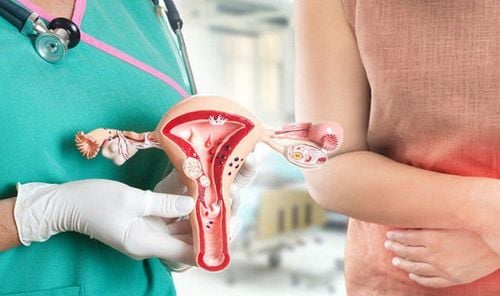This is an automatically translated article.
The article was professionally consulted with Specialist Doctor II Tran Thi Mai Huong - Obstetrician and Gynecologist - Department of Obstetrics and Gynecology - Vinmec Hai Phong International General Hospital.Perimenopause, menopause is a period in which a woman's body undergoes many changes. In particular, the phenomenon of perimenopausal bleeding and post-menopausal bleeding make many women worried. This article will give you everything you need to know about this phenomenon.
1. What are menopause and perimenopause?
Menopause is the time when a woman's menstrual period stops. Menopause is confirmed as 1 year after the cessation of menstruation. The mean age of menopause is 51 years, the normal range is 45 to 55 years.
The years leading up to menopause are called perimenopause. Also means "around the menopause". This phrase means the period of preparation for menopause, which can last as long as 10 years before menopause. During the entire perimenopause, changes in hormone levels can affect the timing of ovulation, which in turn causes changes in the menstrual cycle.
Changes in the menstrual cycle are common during perimenopause. During a normal menstrual cycle, levels of the hormones estrogen and progesterone cyclically rise and fall. Ovulation occurs in the middle of the menstrual cycle, and menstruation occurs 2 weeks later. During perimenopause, hormone levels are no longer cyclical. This leads to vaginal bleeding, vaginal bleeding with the appearance of abnormal blood clots in the vagina. The number of days between menstrual cycles can be increased or decreased. You may also not have a period for a few months.
2. When is perimenopausal and postmenopausal bleeding abnormal?
Any irregular periods occurring after menopause should be recorded in your health log. Although menstrual cycles can be irregular during perimenopause, it can still be a warning that irregular bleeding could be a sign of a problem unrelated to perimenopause. To better describe the symptoms encountered, you need to monitor the menstrual cycle in the following months to detect the following phenomena:
Heavy bleeding. Menstruation lasts longer than usual. Thicker menstrual cycles (< 3 weeks). Bleeding after intercourse or during intercourse.

3. Causes of perimenopausal and postmenopausal bleeding
3.1. Cervical polyps Polyps are benign cells that develop from tissues similar to the endometrium, which are located inside the uterus. They can attach to the uterine wall or grow on the surface of the endometrium, causing irregular or heavy bleeding. Polyps can also exist in the cervix or in the cervical canal. These polyps can cause bleeding after sex.
3.2. Endometrial atrophy After menopause, the endometrium becomes too thin due to a decrease in estrogen levels. This condition is known collectively as endometrial atrophy. In those thin areas, you may experience unusual bleeding.
3.3. Endometrial hyperplasia In this case, the endometrium becomes thicker. Endometrial hyperplasia is often caused by excessive estrogen levels and progesterone deficiency. In some cases, cells in the lining of the uterus grow abnormally. This phenomenon, called atypical proliferation, can lead to uterine cancer. When endometrial hyperplasia is detected and treated early, uterine cancer can often be prevented. Bleeding is a major sign of endometrial cancer after menopause.
4. Diagnosis of perimenopausal and postmenopausal bleeding
To diagnose the cause of irregular bleeding during perimenopause or after menopause, your doctor will ask about your medical history and your family's medical history. You will have a routine physical exam. You may also be ordered to have other tests such as:
Endometrial biopsy : A small tube is inserted to take a sample of tissue from the lining of the uterus. The sample is sent to a laboratory and viewed under a microscope. Pelvic ultrasound: Using an ultrasound device placed on the abdomen or in the vagina. In these devices there are sound waves that can create clear images of your pelvis to look for abnormalities. Sonohysterography — liquid is injected through a tube called a catheter, which makes your uterus more visible during an ultrasound. Hysteroscopy — a thin, light-emitting tube with a camera at the end of the tube, called a hysteroscope. The device is threaded through the vagina and cervix, allowing a view of the inside of the uterus. Dilation and curettage (D&C): The uterus is enlarged, and tissue is scraped or aspirated from the uterine lining. These tissues are taken to a laboratory and examined under a microscope.
5. Treatment of perimenopausal and postmenopausal bleeding

Depending on the cause, the treatment for irregular bleeding during perimenopause and after menopause is different. If growths of benign cells (polyps) are causing the bleeding, surgery is needed to remove them. Endometrial atrophy can be treated with medication. Endometrial hyperplasia can be treated with progestin therapy. This can cause the endometrium to shed. Thickened areas of the endometrium can be removed with cystoscopy, or a D&C.
Women with endometrial hyperplasia have an increased risk of endometrial cancer. They need to have endometrial biopsies regularly to ensure that the disease has been completely treated and there is no risk of recurrence.
Endometrial cancer is treated with surgery (usually removing the uterus and removing lymph nodes near it) in most cases.
Currently, Vinmec International General Hospital has a package of examination and consultation for premenopausal health care, helping customers to examine and consult with a gynecologist; Carry out tests to assess hormonal status, from which to detect perimenopausal diseases early to have the most effective treatment.
When registering for the pre-menopausal health care package and consulting package, customers will receive:
Gynecological examination. Gynecological examination, breast examination. Transabdominal ultrasound of the uterus and ovaries. Take samples for cervical-vaginal cytology. Mammogram (2 sides). Measure osteoporosis. Perform other tests,... Target audience: Women aged 45-55, possibly younger (when suffering from premature ovarian failure), menstrual abnormalities, sexual disorders, suspect an endocrine disorder, or have a need for hormone replacement therapy, or want to prepare yourself for perimenopause and menopause; Clients have risk factors such as smoking, long-term stress, undergoing cancer treatment, having surgery to remove 1 or 2 ovaries; Customers have symptoms such as menstrual irregularities, sexual disorders, changes in psychology, sleep,...
Please dial HOTLINE for more information or register for an appointment HERE. Download MyVinmec app to make appointments faster and to manage your bookings easily.














